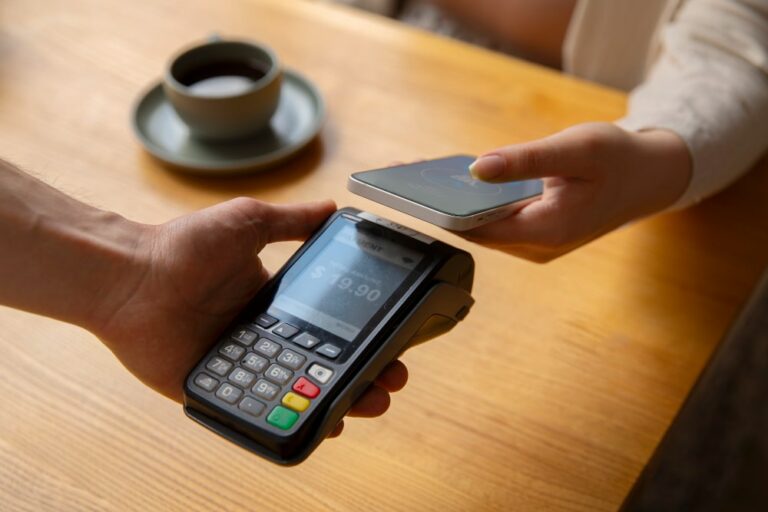In the dynamic landscape of retail, where convenience, speed, and security are paramount, point-of-sale (POS) systems have undergone a remarkable evolution. Gone are the days of clunky cash registers and manual transactions; today’s retail payments have embraced the digital age. In this article, we delve into the fascinating realm of “Evolving Trends in POS Systems: Modernizing Retail Payments,” where innovation and technology are reshaping the way businesses conduct transactions and interact with customers.
The retail sector has witnessed a seismic shift in recent years, driven by changing consumer expectations and rapid technological advancements. As consumers increasingly favor seamless and contactless experiences, traditional POS systems have had to adapt or risk becoming obsolete. This transformation has given rise to mobile POS systems, which are revolutionizing the retail landscape. Mobile devices like smartphones and tablets have become powerful tools for retailers, enabling them to process transactions efficiently, reduce checkout times, and provide customers with a more personalized shopping journey.
One of the defining trends in modern POS systems is the embrace of contactless and near-field communication (NFC) technology. Customers can now make payments with a simple tap or wave, making transactions both swift and secure. Moreover, the integration of artificial intelligence (AI) and data analytics has ushered in an era of data-driven decision-making. Retailers can harness the power of AI to better understand customer behavior, optimize inventory management, and enhance overall operational efficiency. Furthermore, enhanced security measures, such as encryption and tokenization, ensure that sensitive financial information remains safeguarded in an age when cyber threats are ever-present.
As we embark on this exploration of evolving POS trends, we will uncover the exciting ways in which these innovations are reshaping the retail payments landscape, enabling businesses to stay competitive, and providing customers with the modern shopping experiences they crave. Join us on this journey as we dissect the elements driving the future of retail payments and how businesses can harness them to thrive in an increasingly digital world.
The Rise of Mobile POS Systems:
In the fast-paced world of retail, adaptability and agility are the keys to success. The rise of mobile point-of-sale (POS) systems stands as a testament to this fact. Traditional cash registers and stationary POS terminals have given way to sleek, portable devices that empower businesses to meet the evolving needs of customers.
Flexibility and Mobility: Mobile POS systems offer unparalleled flexibility. Retailers can process transactions from anywhere in the store, eliminating the need for customers to queue at a fixed checkout counter. Sales associates armed with tablets or smartphones can assist customers with checkout, product inquiries, and even inventory checks, all on the move. This flexibility not only enhances the shopping experience but also allows retailers to better utilize floor space and streamline operations.
Speed and Efficiency: Time is of the essence in retail, and mobile POS systems significantly expedite the checkout process. Customers no longer need to wait in long lines; instead, they can finalize their purchases swiftly. This speed not only improves customer satisfaction but also contributes to higher sales volumes during peak hours or busy shopping seasons.
Enhanced Customer Engagement: Beyond mere transaction processing, mobile POS systems facilitate meaningful interactions between customers and sales associates. Sales staff can access customer profiles, purchase history, and product recommendations right at their fingertips, providing a more personalized shopping experience. These interactions can foster customer loyalty and drive repeat business.
Contactless Payments: The recent surge in contactless payments, driven by the need for safe and hygienic transactions, aligns perfectly with mobile POS systems. Customers can make payments with a simple tap or scan, reducing physical contact and enhancing security. This trend has gained even more traction in the wake of the global health crisis.
Data-Driven Insights: Mobile POS systems are not just transaction tools; they are data hubs. They collect valuable information about customer behavior, preferences, and purchasing patterns. Retailers can harness this data to refine their marketing strategies, optimize inventory management, and tailor their product offerings. Artificial intelligence and data analytics help transform this data into actionable insights.
As mobile POS systems continue to evolve, they are poised to become an integral part of the retail ecosystem. Their adaptability, speed, and capacity for data-driven decision-making make them a driving force behind the modernization of retail payments. In the following sections, we will explore more facets of this transformation and delve into the technologies and strategies that are propelling the retail industry forward.
Contactless and NFC Payments: Revolutionizing Transaction Security and Speed
One of the most notable trends in the evolution of point-of-sale (POS) systems is the widespread adoption of contactless and Near Field Communication (NFC) payments. This technological innovation has not only streamlined the checkout process but also addressed growing concerns about transaction security, making it a game-changer for modern retailers.
1. The Convenience of Tap-and-Go:
Contactless payments have redefined the shopping experience. Shoppers can simply tap their contactless-enabled cards, smartphones, or wearable devices on the POS terminal, eliminating the need for physical cash or card insertion. This “tap-and-go” approach offers unparalleled convenience, significantly reducing transaction times. Customers appreciate the ease and speed of completing their purchases, fostering positive shopping experiences.
2. Enhanced Security Measures:
With the rise of cyber threats and identity theft, security has become a paramount concern in payment transactions. Contactless and NFC payments incorporate robust security features. Each transaction generates a unique, encrypted code, making it challenging for cybercriminals to intercept or replicate payment data. Additionally, many mobile wallet apps offer biometric authentication, such as fingerprint or facial recognition, adding an extra layer of protection.
3. Hygiene and Health Considerations:
In the wake of global health concerns, contactless payments have gained even more prominence. Customers appreciate the reduced physical contact associated with these payment methods. This added layer of hygiene aligns with evolving expectations for safety during transactions, whether in-store or for online orders with curbside pickup.
4. Expanding Acceptance Networks:
Retailers have recognized the shift in consumer preferences and are increasingly embracing contactless and NFC payments. Merchants across various industries, from grocery stores and restaurants to public transportation, now accept these payment methods. The widespread acceptance of contactless payments has further accelerated their adoption among consumers.
5. The Role of Mobile Wallets:
Mobile wallet applications, such as Apple Pay, Google Pay, and Samsung Pay, have played a pivotal role in promoting contactless and NFC payments. These apps store users’ payment information securely and facilitate transactions through smartphones or wearables. Mobile wallets also support loyalty programs and offer a seamless shopping experience by consolidating payment, loyalty cards, and digital receipts in one place.
6. Future Innovations:
As technology continues to advance, the capabilities of contactless and NFC payments are likely to expand. This includes incorporating additional features, such as public transportation integration, ticketing for events, and secure access to buildings. Moreover, emerging technologies like biometric wearables and decentralized finance (DeFi) integration may further revolutionize the landscape of contactless payments.
In conclusion, contactless and NFC payments have emerged as transformative forces in modernizing retail payments. Their fusion of convenience, security, and hygiene, combined with an expanding network of acceptance, positions them as a vital component of the evolving retail and payment ecosystem. As retailers continue to adapt to changing consumer preferences, contactless and NFC payments are expected to remain at the forefront of these transformations.
Integration of AI and Analytics: Elevating Retail Insights and Customer Engagement
In the realm of evolving trends in point-of-sale (POS) systems, the integration of Artificial Intelligence (AI) and advanced analytics has emerged as a pivotal game-changer. This fusion of cutting-edge technology with retail transactions has far-reaching implications for enhancing customer experiences, boosting sales, and optimizing operational efficiency.
1. Intelligent Inventory Management:
One of the primary areas where AI and analytics shine in the retail sector is inventory management. AI-driven algorithms can analyze historical sales data, seasonality, and even external factors like weather forecasts to predict demand accurately. Retailers can use these insights to optimize stock levels, reduce overstocking or understocking issues, and ensure that products are available when customers want them. This not only saves costs but also enhances customer satisfaction.
2. Personalized Customer Experiences:
AI-powered POS systems have the capability to personalize interactions with customers at the point of sale. Through data analysis, these systems can tailor product recommendations and promotions based on a customer’s purchase history and preferences. This level of personalization not only fosters loyalty but also increases the likelihood of upselling or cross-selling, thus boosting revenue.
3. Streamlined Checkout Processes:
AI and analytics also play a crucial role in streamlining the checkout process. Automated checkouts, powered by computer vision and machine learning, can identify items in a shopping cart without the need for manual scanning. This technology reduces wait times and minimizes the risk of errors. Additionally, predictive analytics can help retailers allocate resources efficiently, ensuring sufficient staff is available during peak shopping hours.
4. Fraud Detection and Prevention:
The integration of AI can significantly enhance security at the point of sale. Advanced algorithms can analyze transaction data in real-time, identifying irregular patterns or potentially fraudulent activities. When unusual behavior is detected, the system can trigger alerts or temporarily halt transactions, protecting both retailers and customers from financial losses.
5. Customer Behavior Analysis:
AI and analytics can delve deep into customer behavior, providing retailers with valuable insights. These systems can track foot traffic, customer dwell times, and even analyze facial expressions to gauge customer sentiment. Retailers can leverage this data to optimize store layouts, product placements, and marketing strategies for better customer engagement.
6. Inventory Forecasting and Supply Chain Optimization:
Beyond individual stores, AI and analytics extend their reach to the entire supply chain. Retailers can use these technologies to forecast demand accurately, optimize shipping routes, and ensure that products are in the right place at the right time. This leads to cost savings, reduces waste, and ensures a more efficient flow of goods from suppliers to consumers.
7. Continuous Learning and Improvement:
One of the key advantages of AI and analytics is their ability to learn and adapt over time. As more data is collected and analyzed, these systems become increasingly accurate in their predictions and recommendations. Retailers can fine-tune their strategies and improve operational efficiency continually.
In conclusion, the integration of AI and analytics into POS systems is reshaping the retail landscape. It empowers retailers to make data-driven decisions, enhance customer experiences, and optimize their operations. As technology continues to advance, we can expect even more sophisticated AI and analytics solutions to further revolutionize the retail industry, ultimately benefiting both retailers and consumers.
Enhanced Security Measures: Safeguarding Retail Transactions
In an era marked by increased digitalization and evolving payment methods, ensuring the security of retail transactions is paramount. One of the standout trends in modern POS systems revolves around implementing enhanced security measures to protect both retailers and customers from the ever-present threat of cyberattacks and fraud. Here, we delve into the innovative approaches that are shaping the landscape of retail security.
1. Multi-Layered Encryption:
Modern POS systems are fortified with multi-layered encryption techniques, making it extremely difficult for malicious actors to intercept and decipher sensitive transaction data. Encryption methods such as Secure Sockets Layer (SSL) and Transport Layer Security (TLS) secure the communication between the POS terminal and payment gateway. Additionally, end-to-end encryption ensures that data remains protected throughout the entire transaction process.
2. Tokenization Technology:
Tokenization is a cutting-edge security measure gaining widespread adoption in the retail sector. This technique replaces sensitive cardholder data with a unique token, rendering the information useless to cybercriminals even if intercepted. Tokens are randomly generated for each transaction, making it virtually impossible to recreate the original card data.
3. Biometric Authentication:
The integration of biometric authentication methods, such as fingerprint scanning or facial recognition, adds an extra layer of security to POS systems. Biometric data is unique to each individual, making it incredibly difficult for unauthorized users to gain access to the system. These authentication methods also enhance the user experience by eliminating the need for passwords or PINs.
4. Real-Time Fraud Detection:
Advanced AI algorithms, combined with machine learning, are employed to detect fraudulent activities in real-time. These systems analyze transaction data and customer behavior patterns to identify anomalies indicative of potential fraud. If suspicious activity is detected, the system can trigger alerts or even halt transactions until further verification is obtained.
5. Compliance with PCI DSS:
Payment Card Industry Data Security Standard (PCI DSS) compliance remains a non-negotiable requirement for POS systems. Adherence to these security standards ensures that retailers implement robust security practices. Regular assessments and audits help maintain the integrity of cardholder data and safeguard against data breaches.
6. Secure Remote Access:
Many retailers now rely on cloud-based POS systems, which demand secure remote access. Secure remote access solutions employ encryption and multi-factor authentication to ensure that only authorized personnel can access the system remotely. This not only enhances convenience but also safeguards against unauthorized intrusion.
7. Device Security Updates:
Regular security updates are essential to patch vulnerabilities in POS hardware and software. Retailers are encouraged to keep their systems up to date to protect against known security threats. Additionally, some POS systems are designed with automatic updates to ensure ongoing protection.
8. Employee Training:
Human error remains a significant factor in security breaches. As such, employee training is vital to maintaining security. Retailers should educate their staff about best practices for data security, including recognizing phishing attempts and practicing safe password management.
In conclusion, the evolving landscape of POS systems places security at the forefront. Enhanced security measures, including encryption, tokenization, biometric authentication, and real-time fraud detection, work in unison to safeguard retail transactions. Compliance with industry standards and ongoing security updates further fortify the retail environment against emerging threats. As technology continues to advance, the integration of robust security measures ensures that modern POS systems are equipped to protect both retailers and customers in an increasingly digital retail landscape.
Conclusion: Shaping the Future of Retail Payments
In the dynamic realm of retail, where transactions have transcended the boundaries of brick-and-mortar stores and ventured into the digital frontier, the role of Point of Sale (POS) systems has evolved significantly. As this article has explored, the evolving trends in POS systems are undeniably modernizing retail payments, elevating both the customer experience and the operational efficiency of businesses.
The rise of mobile POS systems, empowered by smartphones and tablets, has ushered in a new era of flexibility and convenience. Retailers now have the ability to break free from the confines of traditional checkout counters, allowing them to engage customers anywhere within the store. This not only enhances the overall shopping experience but also streamlines the purchasing process, reducing wait times and boosting customer satisfaction.
Contactless and NFC payments have surged in popularity, particularly in a world more conscious of hygiene and social distancing. These technologies have revolutionized how we interact with payment terminals, making transactions swift and secure with just a tap or wave of a card or mobile device. The future undoubtedly holds even more innovation in this space, as we continue to seek frictionless payment experiences.
Integration of AI and analytics has empowered retailers to gain deeper insights into customer preferences and behavior. This data-driven approach enables personalized marketing strategies, which not only increase sales but also foster customer loyalty. Real-time fraud detection, powered by advanced AI algorithms, is a crucial aspect of retail security, safeguarding businesses from financial losses and reputational damage.
Enhanced security measures, ranging from multi-layered encryption and tokenization to biometric authentication and real-time fraud detection, underscore the commitment of retailers to protecting sensitive transaction data. These technologies serve as a bulwark against the ever-present threat of cyberattacks and fraud in the digital age.
The adherence to PCI DSS standards, secure remote access solutions, and regular security updates further fortify the integrity of retail payment systems. However, it’s essential to remember that the human element remains vital. Employee training and awareness are key in mitigating security risks, ensuring that staff members recognize potential threats and adhere to best practices.
In the ever-evolving landscape of retail, the future holds even more promise. As technology continues to advance, POS systems will likely become more integrated, seamless, and intuitive. Embracing these trends and innovations in POS technology is not merely an option but a necessity for retailers seeking to stay competitive and meet the ever-growing expectations of their tech-savvy customers. The transformation of retail payments is a testament to the industry’s adaptability and commitment to enhancing the shopping experience, one transaction at a time.




